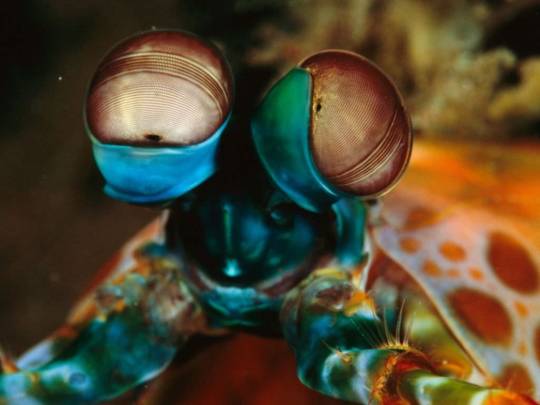#Креветка-богомол Павлиновая
Explore tagged Tumblr posts
Text

















Креветка-богомол Павлиновая или рак-богомол (лат. Odontodactylus scyllarus).
Самцы креветки-богомола обладают очень яркой внешностью. Они переливаются всеми цветами радуги. Тело у них – ярко-зеленое, голова – голубая, передние конечности и антенны – ярко-красные или оранжевые. Самочки не такие пестрые. Чаще всего они имеют коричневый или оливковый окрас.Эти креветки могут достигать 30 сантиметров. Тело их сплющено и вытянуто.
Название «богомол» им приписали за способность мгновенно выбрасывать свои передние конечности. Такой же прием насекомое использует во время защиты от врагов или добывания пищи. По словам биолога Роя Колдуэлла, такой удар у богомола занимает всего 100 миллисекунд, это сравнимо с одним морганием глаза. Удар креветки-богомола в 50 раз быстрее!!! Это самое быстрое движение, на которое способны животные. Но самым удивительным у этого животного являются его глаза. Они имеют сферическую форму и поделены по центру параллельными линиями. Главное то, что они способны воспринимать и преобразовывать поляризованный свет, чего люди делать не могут. Кроме того, эти креветки имеют уникальное зрение, которое позволяет им видеть предметы в оптическом, инфракрасном и ультрафиолетовом диапазонах спектра. Это помогает им распознавать флуоресцентные метки на других креветках в качестве сигналов об опасности или как сигналы угрозы друг другу.
Креветки-богомолы не зря зовутся страшными ��азваниями, вроде «раки-террористы» и «резатели пальцев». В их меню входят крабы, моллюски, улитки, черви, креветки и рыба. Более того, павлиновые креветки – единственные, кто способен полакомиться ядовитым синекольчатым осьминогом, яд которого может убить человека за 15 минут, а противоядия к нему не существует до сих пор.
Ареалом обитания этим красивых и необычных ракообразных является район Барьерного рифа в Австралии. Встречаются они на глубине 40 метров.Живут креветки в самодельных песчаных норках или в коралловых обломках. Длина этих нор может достигать 1 метра, а глубина доходить до 40 сантиметров. Для укрепления, ее стенки креветки покрывают кусочками раковин и частичками кораллов.
Peacock Mantis Shrimp or Mantis Shrimp (Latin: Odontodactylus scyllarus).
Male mantis shrimps have a very bright appearance. They shimmer with all the colors of the rainbow. Their body is bright green, their head is blue, their forelimbs and antennae are bright red or orange. Females are not so colorful. Most often, they have a brown or olive color. These shrimps can reach 30 centimeters. Their body is flattened and elongated.
The name "mantis" was attributed to them for the ability to instantly throw out their forelimbs. The insect uses the same technique when defending itself from enemies or getting food. According to biologist Roy Caldwell, such a strike by the mantis takes only 100 milliseconds, which is comparable to one blink of the eye. The strike of the mantis shrimp is 50 times faster!!! This is the fastest movement that animals are capable of. But the most amazing thing about this animal is its eyes. They are spherical and divided in the center by parallel lines. The main thing is that they are able to perceive and transform polarized light, which people cannot do. In addition, these shrimp have unique vision, which allows them to see objects in the optical, infrared and ultraviolet ranges of the spectrum. This helps them recognize fluorescent marks on other shrimp as signals of danger or as signals of a threat to each other.
It is not for nothing that mantis shrimp are called scary names, such as "terrorist shrimp" and "finger cutters". Their menu includes crabs, mollusks, snails, worms, shrimp and fish. Moreover, peacock shrimp are the only ones who can feast on the poisonous blue-ringed octopus, whose venom can kill a person in 15 minutes, and there is still no antidote to it.
The habitat of these beautiful and unusual crustaceans is the Barrier Reef area in Australia. They are found at a depth of 40 meters. The shrimp live in homemade sand burrows or in coral debris. The length of these burrows can reach 1 meter, and the depth can reach 40 centimeters. To strengthen it, the shrimp cover its walls with pieces of shells and coral particles.
Источник: /ianimal.ru/topics/krevetka-bogomol, /www.techinsider.ru /science/611573-samyy-bystryy-udar-v-okeane-v-chem-sekret-krevetki-bogomola/, //masterok. livejournal.com/1508581.html, //animals.pibig.info/27111-pavlinovaja-krevetka-bogomol.html, //t.me/+fxNu20lM26MwYzhi.
#video#animal video#nature#marine life#marine biology#aquatic animals#crustaceans#Odontodactylus scyllarus#Peacock Mantis Shrimp#mantis crab#underwater#ocean#reef#sea anemones#animal photography#nature aesthetic#видео#фауна#природнаякрасота#природа#океан#ракообразные#Креветка-богомол Павлиновая#рак-богомол#риф#актинии#анемон
185 notes
·
View notes